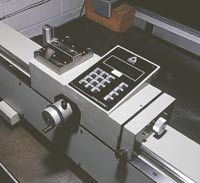Meeting Rotating Part Specs Focuses
Machine Shop On Quality Inspection...
It's axiomatic
in the metalworking industry that for quality production, a measuring
gage has to be ten times more accurate than the part it measures.
"We call it a gage R&R of ten percent," says Willie Michaely,
quality assurance manager of NCI, Inc. (Asheville, North Carolina)
of Dowty Aerospace and a member of the British TI Group.
 |
|
 Gary Scott, gage laboratory technician at NCI Inc., checks
and calibrates a bar gage used in the shop with the Fowler-Trimos
TELMA Inspection System.
Gary Scott, gage laboratory technician at NCI Inc., checks
and calibrates a bar gage used in the shop with the Fowler-Trimos
TELMA Inspection System.
|
NCI is a 35-year-old
precision machine shop specializing in rotating parts for aerojet
engines. Its major customers include General Electric and Pratt
& Whitney in the United States and Snecma (France) and Alfa
Romeo and Fiat (Italy)—all manufacturers of gas turbine engines
used in civilian and military aircraft as well as power generation
machinery. NCI manufactures all types of rotating parts, including
turbine rotating air seals, cooling plates and blade retainers.
The company needs precise part measurements required by such high-performance
machinery. More than ten years ago, NCI was using instruments that
had a smaller capacity and less accuracy than it needed. The company
decided to purchase the Fowler/Trimos horizontal setting family
of instruments from Fred V. Fowler Co., Inc. (Newton, Massachusetts)
to replace these. "When we were reviewing available measuring devices,
compared with others, this Swiss-made setting system had significantly
better accuracy," Mr. Michaely says. "Of equal significance to us
was its ease of use and the brief training needed.
"They are accurate
down to the millionths. If my parts need to be ±0.001 inch, then
the gage has to be accurate within ±0.0001 inch, which these Fowler/Trimos
setting gages are," he adds.
NCI's companywide
quality program not only meets ISO 9002 certification but also AS
9000, which adds 40 additional elements to the required ISO ratings,
says Mr. Michaely. The program, clearly required by the tight tolerances
involved in sensitive rotating machinery such as gas and steam turbines,
has been in place for several years.
"Our customers
demand our adherence to extremely tough quality standards, because
when turbines fail, the downtime costs are enormous for their customers,"
he adds. "Every part has its own serial number, and records must
be kept on it from raw material through manufacturing for its lifetime."
The company
now has two models of the system. The 40-inch model of the Trimos
system was the first one purchased some ten years ago, while the
newer 60-inch version has been in service for a little more than
a year, reflecting the larger size components being manufactured
today.
 |
 Trimos electronics and functions focus on operator ease of use
and accuracy.
Trimos electronics and functions focus on operator ease of use
and accuracy. |
Revamped and improved, the latest model with digital readout features
a new scale and electronic display unit on which functions have been
adapted to meet horizontal measurements such as MIN/MAX, RS232 data
output; and accuracy of 0.000250 inch. The scale has been relocated
to the instrument's back for enhanced protection.
Overall, these
setting instruments have been used fulltime by NCI to set all internal
and external gages as well as to check lengths, internal diameters,
pitch diameters of internal threads, bore gages, micrometers, snap
and dial gages, among others.
NCI's wide range
of production takes advantage of cellular manufacturing and many
four- to five-axis machining centers working a long list of metals
and high temperature alloys, from Rene 88, Waspaloy and various
titanium alloys to many Hastelloys, Inconels and steel and stainless
alloys. Because of this, the company is able to employ the Trimos
horizontal setting instruments on almost any product, says Mr. Michaely.
Both machine
utilization (the company's CNC lathes and machining centers number
more than 50 in the 70,000-square foot facility, recently expanded
another 21,000 square feet) and quality rank high at NCI. Every
day cell leaders report productivity, utilization and efficiency
of every machine in the plant. The report also shows any deviations
in quality over the past 24 hours. This prevents small problems
from turning into major productivity or quality issues.

